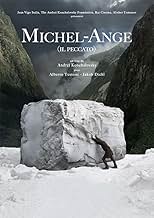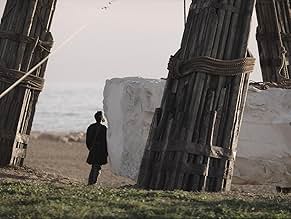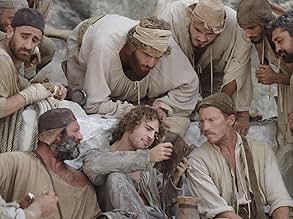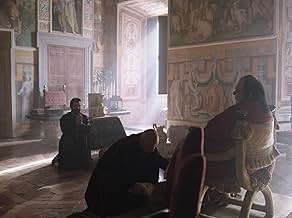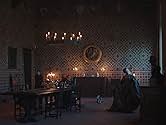VALUTAZIONE IMDb
6,8/10
1457
LA TUA VALUTAZIONE
La vita di Michelangelo Buonarroti.La vita di Michelangelo Buonarroti.La vita di Michelangelo Buonarroti.
- Regia
- Sceneggiatura
- Star
- Premi
- 3 vittorie e 2 candidature totali
Recensioni in evidenza
The main thing I would like to point out is that every single scene from this movie was like a beautiful painting straight out of an Italian museum. I can't remember when was the last time the visuals of a movie stunned me so greatly that I was with each scene change surprised by the beauty of the images.
Secondly, the feeling I get reading the rest of the reviews, and hearing other people comment on the movie, is that that people almost expect this movie to be a some sort of thriller depicting the genius of Michelangelo, the person we all know as the one of the worlds greatest artists of all time. But the greatness of this movie is in the contrary - Michelangelo is portrayed as a mere, sinning human - who steals, betrays, lies, and also hates showering. He is a imperfect person just like any other, haunted by his fears and suspicions and I can't shake off the feeling that people did not (or did not want) to see Michelangelo in those lens. But for me that is the main thing that makes this movie so great - the viewer can share Michelangelos' emotions and thoughts as if they were their own or of their friend, since the artists is another common, but very talanted man, and not some untouchably skilled alien of the past.
Thirdly, the movie shows us only a fragment of the artists life, and a fragment describing the very beginning of the sculpting process, and it is that time that the fullness of Michelangelos' character can be met, like it is in the movie. Who wants to see a historical documentary about his whole life? You can tune into the History channel if your into that. On the other side, the movie is an artistic take at an artists life, excellently describing Michelangelos true identity, his problems and thoughts, related or not to his work.
For me, the point and the idea of the movie is that Michelangelos works such as David and Pieta were not thought up in the vast and luxuriose castles and churches of Florence, while the artists was enjoying a cup of tea snf reading philospophy, but instead, in the middle of a marble mine in high up in the mountains, alongside plain working men, when the idea arises in sight of a mere daughter of one of the workers leans on a marble rock for a short afternoon sleep - it is that plain scene which inspires the divine masterpiece of the artists work today. This is what makes the movie so down to earth and realistic, and in combination with the incredible scenery, makes the viewer feel like he is in 16th century Italy for two hours.
Secondly, the feeling I get reading the rest of the reviews, and hearing other people comment on the movie, is that that people almost expect this movie to be a some sort of thriller depicting the genius of Michelangelo, the person we all know as the one of the worlds greatest artists of all time. But the greatness of this movie is in the contrary - Michelangelo is portrayed as a mere, sinning human - who steals, betrays, lies, and also hates showering. He is a imperfect person just like any other, haunted by his fears and suspicions and I can't shake off the feeling that people did not (or did not want) to see Michelangelo in those lens. But for me that is the main thing that makes this movie so great - the viewer can share Michelangelos' emotions and thoughts as if they were their own or of their friend, since the artists is another common, but very talanted man, and not some untouchably skilled alien of the past.
Thirdly, the movie shows us only a fragment of the artists life, and a fragment describing the very beginning of the sculpting process, and it is that time that the fullness of Michelangelos' character can be met, like it is in the movie. Who wants to see a historical documentary about his whole life? You can tune into the History channel if your into that. On the other side, the movie is an artistic take at an artists life, excellently describing Michelangelos true identity, his problems and thoughts, related or not to his work.
For me, the point and the idea of the movie is that Michelangelos works such as David and Pieta were not thought up in the vast and luxuriose castles and churches of Florence, while the artists was enjoying a cup of tea snf reading philospophy, but instead, in the middle of a marble mine in high up in the mountains, alongside plain working men, when the idea arises in sight of a mere daughter of one of the workers leans on a marble rock for a short afternoon sleep - it is that plain scene which inspires the divine masterpiece of the artists work today. This is what makes the movie so down to earth and realistic, and in combination with the incredible scenery, makes the viewer feel like he is in 16th century Italy for two hours.
10whotheff
Instead of being 24 pictures per second, this movie is 24 paintings per second. Contrary to modern cinema camera is very still. Instead of boring, static actors, we have static frames with a lot of movement in them with perfect angles for every single shot. It was so full of atmosphere, 100% realism and natural sounds that I did not blink for two hours. But instead of being some fancy art film, it tells a story which is very passionate, moving, dynamic. The protagonist lives through heaven and hell in following hos passion and this is so natural and real, that combined with the perfect atmosphere and realism, it made me feel as if I was there with him. And I've seen quite a lot of movies and hard to impress. Every scene, every inch of the screen, every sound, every second has meaning. Even quiet, still shots are felt so heavy, that there is no doubt you would feel them too.
The feeling of the age is so true, everything is so analog. As if no computer was used in the making of this film. I can only imagine the tons of hard work put into it to create this realism. Now I want to see more of Konchalovsky!
The feeling of the age is so true, everything is so analog. As if no computer was used in the making of this film. I can only imagine the tons of hard work put into it to create this realism. Now I want to see more of Konchalovsky!
Up until the final scene, Il Peccato seems a beautiful chaos, with an apparently random series of scenes that seem to go nowhere in particular. But, alas, the finale might be enlightening.
Konchalovsky's film obviously echoes Andrei Rublev, even though it can't be but a shadow if compared to Tarkovsky's masterwork, by portraying Michelangelo as a troubled artist that feels out of place in his brutal times. Unlike Rublev, Michelangelo is however torn by less religious themes, even though he too complains about the brutality of his commissioners, the Della Rovere and the Medici families. Always in economic difficulties, always aspiring to a sublime that he identifies in poet Dante Alighieri, never able to settle in one place, fueled by an inner omnipresent rage. Ultimately, Michelangelo's titular 'sin' is not revealed, but it might be pride: he makes no secret of how he considers himself to be a genius far above anyone else, he tries to do overly impossible things without accomplishing them entirely. A physical representation of his pride might constitute the huge marble block seen in the poster, that pays a specific role in part of the film.
The cast is made up of less well-known italian actors, but Alberto Testa in particular seems the perfect choice in terms of appearance to play the Renaissance Sculptor. Equally particular is the choice to shoot the movie in 4:3 aspect ratio. The coloring however somehow reminded of Sokurov's Faust.
As a biopic about Michelangelo, it will most likely leave you with more questions about the man that you initially had. The narrative is very cryptic and revolves around him trying to balance his art around commissions and orders he has no hope of actually fulfilling.
Most of the movie is spent on "the monster," a marble block he considers more important than any of his responsibilities or desires. But when it comes down to actually watching the transportation, it is just an accident waiting to happen. You know that it's coming, and yet it is surprising nonetheless when it does.
The plot is stitched with bits and pieces of his life and relationships with multiple Popes he lived through. It only makes sense if you already know anything there is to know about his biography. The movie will not bother establishing differences between the pope factions or highlighting the significance of the events. You are on your own in this one.
His character also becomes more confusing as it goes along, his clear perfectionism and suspicion of everyone stem from vaguely alluded conspiracies around him that start and end abruptly, sometimes in the same scenes. His obsession with the monster and willingness to betray everyone and everything for it is captivating, however, his revelation at the end just seems way too nebulous for it to be understood by anyone except him, and maybe this is how it should be. The best aspect of Michelangelo that the movie so carefully and authentically portrays is that, despite looking like a local madman who has to beg on a street, he was never poor; his tight-fistedness is something of a legend in and of itself. Including a chest full of ducats under his bed that he just doesn't spend while living in what amounts to poverty.
Speaking of which, the mise-en-scene of the medieval cities is impeccable. It's one of those ultra-authentic dirty movies that doesn't resort to erasing color everywhere to show the dirt. No, everything can be vibrant while the roads are made of layers upon layers of mud. That's not a contradiction. Everyone is sweaty with their unwashed clothes full of holes and tears. All this only highlights the absolute beauty of his creations.
Most of the movie is spent on "the monster," a marble block he considers more important than any of his responsibilities or desires. But when it comes down to actually watching the transportation, it is just an accident waiting to happen. You know that it's coming, and yet it is surprising nonetheless when it does.
The plot is stitched with bits and pieces of his life and relationships with multiple Popes he lived through. It only makes sense if you already know anything there is to know about his biography. The movie will not bother establishing differences between the pope factions or highlighting the significance of the events. You are on your own in this one.
His character also becomes more confusing as it goes along, his clear perfectionism and suspicion of everyone stem from vaguely alluded conspiracies around him that start and end abruptly, sometimes in the same scenes. His obsession with the monster and willingness to betray everyone and everything for it is captivating, however, his revelation at the end just seems way too nebulous for it to be understood by anyone except him, and maybe this is how it should be. The best aspect of Michelangelo that the movie so carefully and authentically portrays is that, despite looking like a local madman who has to beg on a street, he was never poor; his tight-fistedness is something of a legend in and of itself. Including a chest full of ducats under his bed that he just doesn't spend while living in what amounts to poverty.
Speaking of which, the mise-en-scene of the medieval cities is impeccable. It's one of those ultra-authentic dirty movies that doesn't resort to erasing color everywhere to show the dirt. No, everything can be vibrant while the roads are made of layers upon layers of mud. That's not a contradiction. Everyone is sweaty with their unwashed clothes full of holes and tears. All this only highlights the absolute beauty of his creations.
This movie has left me without blinking during the more than two hours it lasts. With beautiful photography, a hard and dry plot, and hypnotic images for its approach to an Italian Renaissance as it must have been in reality, dirty, poor and tremendously unfair.
The actors seem sculpted against the beautiful background of Tuscany with the same rawness that we find in Pasolini's films. We must not forget that Konchalovskiy collaborated with Tarkovsky in the birth of the story of another tormented artist, 'Andrei Rublev', one of his masterpieces.
From the beginning of the film we see Michelangelo in his maturity, when the intense and fierce compulsion of his sculptural works, which seem to relax only in his 'Pieta', are those of a man pursued by 'the devil' -as his character says-, obsessed by money, in a purely masculine world, far from femininity, compassion and subtlety.
The central scene of 'Il Peccato' has been compared to a certain scene in the movie 'Fitzcarraldo' and they are not wrong, because there is dementia linked to the search for a goal that constantly escapes, no matter how much effort is made, and all this is told in a way that takes your breath away. Although it is not a drama, it is the life of someone at the limit of his strength.
Highly recommended.
The actors seem sculpted against the beautiful background of Tuscany with the same rawness that we find in Pasolini's films. We must not forget that Konchalovskiy collaborated with Tarkovsky in the birth of the story of another tormented artist, 'Andrei Rublev', one of his masterpieces.
From the beginning of the film we see Michelangelo in his maturity, when the intense and fierce compulsion of his sculptural works, which seem to relax only in his 'Pieta', are those of a man pursued by 'the devil' -as his character says-, obsessed by money, in a purely masculine world, far from femininity, compassion and subtlety.
The central scene of 'Il Peccato' has been compared to a certain scene in the movie 'Fitzcarraldo' and they are not wrong, because there is dementia linked to the search for a goal that constantly escapes, no matter how much effort is made, and all this is told in a way that takes your breath away. Although it is not a drama, it is the life of someone at the limit of his strength.
Highly recommended.
Lo sapevi?
- QuizShot entirely in Italy. The movie was shot in Rome and its environs and in Tuscany, including at the Carrara quarry where Michelangelo got his marble.
- Citazioni
Michelangelo Buonarroti: Money always rubs elbows with infamy.
- ConnessioniReferenced in Večernij Urgant: Andrei Konchalovsky/Pompeya (2019)
I più visti
Accedi per valutare e creare un elenco di titoli salvati per ottenere consigli personalizzati
- How long is Sin?Powered by Alexa
Dettagli
Botteghino
- Budget
- 15.000.000 € (previsto)
- Lordo in tutto il mondo
- 243.043 USD
- Tempo di esecuzione2 ore 14 minuti
- Colore
- Proporzioni
- 1.33 : 1
Contribuisci a questa pagina
Suggerisci una modifica o aggiungi i contenuti mancanti

Divario superiore
By what name was Il peccato - Il furore di Michelangelo (2019) officially released in India in English?
Rispondi
![Guarda Trailer [OV]](https://m.media-amazon.com/images/M/MV5BYThkZDVkMGQtNGZiYS00NzMwLWFkOWUtYTFhYThiN2E4MTQwXkEyXkFqcGdeQXRyYW5zY29kZS13b3JrZmxvdw@@._V1_QL75_UX500_CR0)
